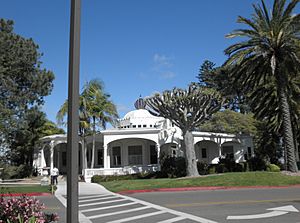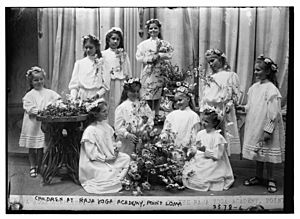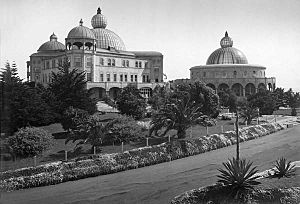Lomaland facts for kids

Lomaland was a special community in Point Loma, California. It was founded in 1900 by Katherine Tingley, a leader of the Theosophical Society. Lomaland was a school, a cultural center, and a home for people who followed Theosophy. It also served as the main office for the American branch of the Theosophical Society Pasadena.
This community was very important to San Diego. It offered many cultural events and left behind beautiful buildings. Today, these buildings are part of Point Loma Nazarene University. The people of Lomaland also planted many trees and gardens. Because of them, the area is now known as the "Wooded Area".
Katherine Tingley wanted to create a "White City" that showed the ideas of Theosophy. This community blended new American confidence with older traditions and Indian spirituality. This mix created unique buildings that you can still see at Point Loma Nazarene University.
Contents
The Story of Lomaland: A Unique Community
Lomaland began when Gottfried de Purucker visited Point Loma in 1894. He later told Katherine Tingley about the beautiful location. In 1897, Tingley bought land there. She laid the first stone for a special school called the School for the Revival of the Lost Mysteries of Antiquity.
By 1899, Tingley moved to Lomaland. In 1900, the Universal Brotherhood and Theosophical Society also set up its main office there. The community wanted to grow its own food. They planted many different fruits and trees, like avocados and oranges. Katherine Tingley wanted fresh fruits and vegetables served every day.
Learning at Lomaland: The Raja Yoga School
In the summer of 1900, the Raja Yoga school opened at Lomaland. "Raja Yoga" means "divine union." The school focused on teaching not just facts, but also good morals and spiritual growth. It was a boarding school where over 300 students lived in homes called "Lotus Houses." Children from poor families could attend for free.
Students at the school learned many things. They performed classical plays and works by Shakespeare. Every student had to learn to play at least one musical instrument. After 1905, the school had the first student orchestra in the United States. This orchestra gave weekly concerts and even went on tour.
Over the years, more buildings were added. An open-air Greek theater was built in 1901. A temple followed, and then a college in 1914. By 1919, Lomaland had its own Theosophical university. Other buildings included a hotel, a textile factory, a bakery, and a publishing house. About 60 percent of the community members were women. Many women also held leadership roles, which was quite unusual for that time.
The Theosophical university offered courses in arts and sciences. It was approved by the state of California. In 1942, the university moved to Covina. The publishing house at Lomaland changed its name a few times, but it always printed books about Theosophy.
Lomaland's Special Buildings and Architecture
At its busiest, Lomaland had many unique buildings. The main ones were the Academy Building and the Temple of Peace. These buildings had a special style. They featured flattened arches and fun designs that looked like ancient art. The tops of the buildings had purple domes that glowed at night, visible from the ocean.
The entrance to the Temple of Peace had two huge carved doors. These doors represented important Theosophical ideas about spiritual wisdom. Today, these doors are kept safe in the San Diego Historical Society archives. The artist, Reginald Machell, moved to Lomaland in 1899. He also designed the furniture inside the Academy Building.
Lomaland had public buildings for everyone and several private homes. The home of Albert Spalding, a famous sporting goods businessman, was built in 1901. This building mixed old Victorian wooden styles with ancient designs. For example, its columns looked like papyrus leaves. The purple dome on this building was fixed up in 1983.
The first Greek theater in North America was built here in 1901. It was used for sports and plays. More decorations were added in 1909. Many Greek and Shakespearean plays were performed there.
Cabrillo Hall was finished in 1909. It served as the main office for the Theosophical Society. Katherine Tingley also lived there after 1909. It was moved to a new spot in the early 2000s. Today, Cabrillo Hall is home to the Communication Studies department at the university.
The Executive Building was where visitors were greeted. It handled phone calls and mail. In 1908, it became a display center for women's crafts. The inside of this building had a special roof design that used squares and circles. These shapes were symbols of heaven and earth.
What Happened After Lomaland?
Lomaland closed down after the difficult economic times of the 1930s. Katherine Tingley passed away in 1929. In 1942, the campus was sold to George W. Wood. The Theosophical Society and its students moved to Covina, near Los Angeles.
Wood first planned to build many homes on the site. However, due to rules and the condition of the buildings, he could only bring in a few hundred people. After Wood died, the property was bought by Balboa University in 1950.
That same year, Balboa University became connected with the Methodist Church. It changed its name to California Western University and moved to Lomaland. Later, in 1973, Pasadena College moved to the site. Pasadena College was then renamed Point Loma College, and finally Point Loma Nazarene University. It remains at this location today.
|
See also
- Rosicrucian Egyptian Museum
- Sibyl Anikeef, raised in Lomaland
- Theosophical Society Point Loma - Blavatskyhouse




